Aonla in foothills of Arunachal Pradesh
Aonla in foothills of Arunachal Pradesh
Introduction
Aonla or Indian gooseberry (Emblica officinalis) is regarded as Amritphal. It is an indigenous fruit to Indian subcontinent. Its fruits are a rich source of vitamin ‘C’. Fruits have been reported to be useful in haemorrhages, diarrhoea, dysentery, anaemia, jaundice, dyspepsia and cough. Trifala and chavanprash are well-known indigenous medicines in Ayurvedic system prepared from aonla. Besides fruits, leaves bark and even seeds are being used for various purposes. Though aonla is not utilized as table fruit it is commercially utilized for processing industries and products like morabba, chatni, squash, candy, toffee shreds, sauce are prepared besides used in cosmetic industries as shampoo, hair oil, dyes, etc.
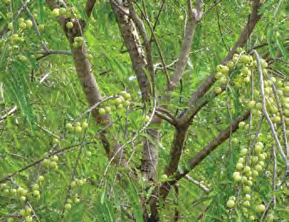
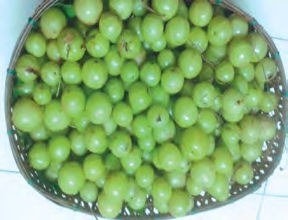
In India its commercial cultivation is very common in Uttar Pradesh. Its intensive plantation is being done in the salt- affected areas of Utter Pradesh. Aonla cultivation is spreading rapidly in the semi-arid regions of Maharashtra, Gujarat, Rajasthan, Andhra Pradesh, Karnataka,Tamil Nadu and Himachal Pradesh. Though aonla is not commercially cultivated in the North Eastern, it is commonly found either in homestead or growing in wild which indicates its adaptability. However, there are variation in existing natural population with respect to tree vigour, fruiting behaviour, yield and quality characters. (Hazarika et. al., 2009).
Climate and soil
Aonla is a subtropical plant and prefers dry subtropical climate but it can be grown in wide range of climatic conditions. The natural growing plants can be seen on hills upto 1800 MSL. The plants are susceptible to winter frost. A mature aonla tree can tolerate freezing as well temperature of 46OC.
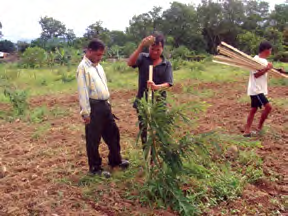
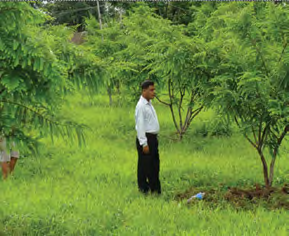
Aonla is a hardy plant and it can be successfully grown in variable soil conditions - an ideal plant for arid and semi-arid conditions. Aonla can easily be cultivated in marginal soils. Heavy soils or land with high water table are are not suited for its cultivation. The deep, fertile, well drained sandy loam soil is ideal for aonla cultivation. Aonla plants can tolerate pH up to 9.5, ESP - 35 and ECe 6-9 dsmˉ1 (Dixit,1987).
Varietal wealth
A lot of varietal improvement works on aonla was done at Narendra Dev University of Agriculture and Technology, 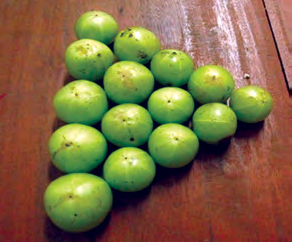
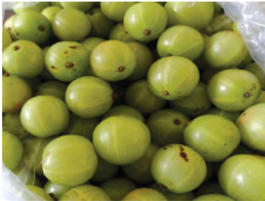 Faizabad and also in GAU, Gujarat. Some of the varieties developed are - Banarasi Chakaiya, Francis (Hathi Jhool), Neelum (NA7), Kanchan, Krishna, N.A.-9, NA-6, NA-10, NA-8, Anand-1, Anand- 2, Lakshmi-52, BSR-1. Out of these, NA-7 was planted in CAU farm.
Faizabad and also in GAU, Gujarat. Some of the varieties developed are - Banarasi Chakaiya, Francis (Hathi Jhool), Neelum (NA7), Kanchan, Krishna, N.A.-9, NA-6, NA-10, NA-8, Anand-1, Anand- 2, Lakshmi-52, BSR-1. Out of these, NA-7 was planted in CAU farm.
Propagation
Aonla can be propagated by seeds but the plants will not be true-to-type for which budding is the most efficient method. Patch budding showed better response followed by modified ring budding.
Budding operation should be performed from mid-May to mid- August for better success, which may be continued up to September with appreciable success (Pathak et al; 1991). However,Saroj et al. (2001) reported that more than 90 per cent success can be obtained through patch budding when perforated polythene bags were used for raising root stocks under irrigated hot arid eco-system. Six months to one-year-old seedling obtained from ‘desi’ aonla tree are being used as rootstock. Mature aonla fruits are collected during January-February and their seeds are extracted after drying. Seeds are sown in raised beds from April onwards and these are transplanted in separate bed for subsequent budding.
Rejuvenation of older and unproductive trees can be rejuvenated by top working. Generally, inferior trees can be headed back to a height of 1.2m from the ground during March and stump produced shoots can be budded in June with scion of improved cultivars.
Planting
Grafting or budded aonla plants are planted during July-August or February. Pits of 1-1.25m length,1- 1.25m breadth and 1-1.25m depth are dug 2 months prior to planting. In each pit 3-4 basket of well-rotten farmyard manure and 1kg neem cake or 500 g bone-meal are mixed with soil and filled.
Canopy management
The canopy management is important to develop canopy architecture and regulate the cropping.The recommended training method is modified centre leader system. The framework should be developed by encouraging the growth of four to six well-spaced branches with fairly wide angle. 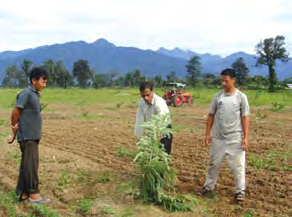
Nutrient Management
The dose of manure and fertilizers depends upon soil fertility, age of plant and production. Every mature tree should be fertilized with 1 kg Nitrogen, 500 g phosphorus and 500 g muriate of potash.This dose should be given in two split doses, once during September and again during April-May after setting of fruit.
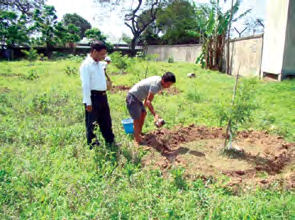
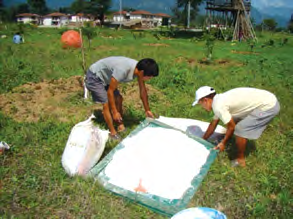
Irrigation
The young plants require watering during summer month at fortnightly interval, particularly till their establishment. No irrigation is required during rainy season. However, irrigation at 15-20 days interval is desirable in dry summer particularly during early years of orchard establishment under wasteland conditions. Mulching with organic wastes are helpful in improving the organic-matter content.
Intercropping
Interspaces between the plant rows can be utilized by intercropping which may provide some additional income to the growers in early years and also provide soil cover. Aonla being a deep-rooted, deciduous tree with sparse foliage, vegetables, flowers and a few medicinal and aromatic plants are well-suited for intercropping.
Harvesting
Changes in colour of fruit from creamy-white to brown is an indication of fruit maturity. Generally fully developed fruits are harvested. A budded/grafted aonla tree starts bearing third year onward after planting, whereas a seedling tree may take 6-8 years. Vegetatively propagated plants attain full bearing within 10-12 years.
Last Modified : 2/12/2020
This topic provides information about Causes, targ...
This topic provides information about 20th Livesto...
The Article provides information about Antioxidant...
This topic deals with information related to Anxie...
